Growing up in Southern California, there was always an intermittent thought hidden somewhere in the back of my mind, the realization that I needed to visit the Watts Towers. Those skeletal towers -with a backdrop of blue sky- I had seen in photographs for as long as I could remember.
Finally the pieces clicked into place and I had the time and the inclination to visit, so I went trolling on the internet, and found that I knew absolutely nothing about the towers. I had assumed they had something to do with the Watts Riots, that it were some sort of memorial for those horrible days. Some sort of remembrance to never let that sort of thing happen again.
I was completely wrong.
Being from Los Angeles, I checked the map for the best way to drive to the towers, because public transport in this city sucks. But in my search I found a Metro station right next to the towers. This made me smile, because there are so few times when a train station is anywhere near where I want to go, and it means I can also watch the public, in their myriad forms, on the train.
Later I found that the man who built the towers did it here for a reason; he wanted the public to see the towers when they sped past on the daily commute. Something to lighten their day, each day. Now the towers sit near the 103 Road Metro Station.
A few days later a friend questioned if it was a good idea to travel to this part of town, and taking the Metro to do it, and I can understand their worry. As the train heads south from downtown Los Angeles the buildings on each side of the tracks transform from graffiti covered industrial buildings, to houses surrounded with graffiti covered fences. All the houses have bars on the windows.
This is Watts, of the infamous Watts Riots of 1965, and it’s sad to say that the economic situation of this area has not improved much in the last 45 years.
But please don’t let that stop you from visiting the towers, because they are beautiful and amazing and –it makes me feel slightly guilty to say this- only 1000 feet south of the station.
Walking next to the Metro tracks, the 100-foot towers are the beacons on where to go. As I got closer I could see yellow school busses parked next to the little green park, and the school children sitting about in groups, obviously on a day out from school, to collect a little culture.
There is a white fence that surrounds the grounds, and my first thought was how small the space that encloses the towers was, compared to the height of the towers. It is just a small parcel of triangular land, the size to fit one small house, but the towers climb out of this small space, majestically out into the blue sky of Los Angeles.
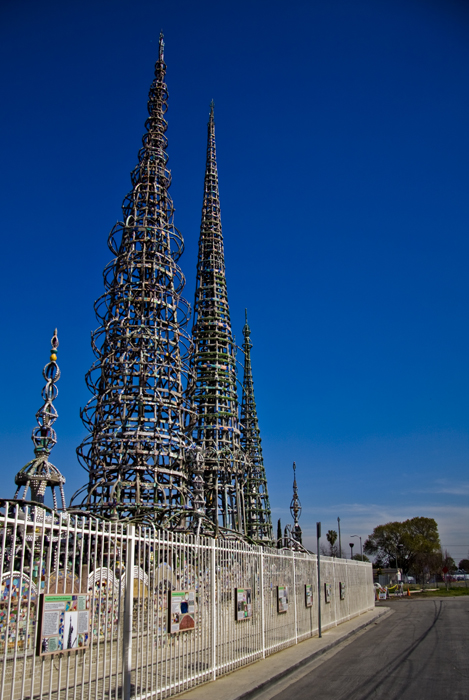
The security guard at the gate said I needed to visit the office and art gallery to purchase a ticket before going on a tour. Inside the office I paid my $7 and wandered about the exhibits until the time of my tour arrived. Individuals are not allowed to walk around the towers alone, as much of it is fragile, and little pieces go missing.
In the main art gallery was an exhibit of local artists who had done their paintings on household times like shovels and old signs. In another room there was a short film, made in the 1950’s describing the man who built these towers, Sam Rodia, who had absolutely nothing to do with the Watts Riots.
By the time of my tour, the children had climbed back aboard their busses and headed back to school, so there were just three of us on the tour. The tour itself was short, as there is not much space to walk around under the towers, but the area is so filled with details, and the towers so wonderfully strange, and the history of the man so interesting.
Sam Rodia was born in Italy in 1875 or 1879 depending on where you get the information. He immigrated to America with his brother who subsequently died in a mining accident in Pennsylvania. Mr. Rodia then moved to Seattle, where he married in 1902 and had three children. The family then moved to San Francisco, where his wife moved out in 1909 using phrases like “general neglect†and ‘the drunken bum.â€
From 1909 to 1920 nothing definite is known of his life, but he told stories of fighting in WWI and traveling in Mexico, but none have been substantiated.
Mr. Rodia arrived in Long Beach in 1920 and soon moved to Watts, buying the property where the towers stand in 1929. It was at this point, somewhere near the age of 50, standing four foot ten inches tall, he began to build his towers.
Over the whole of the thirty years it took him build the towers, Sam Rodia kept his day job as a tile setter. He worked on the towers on weekends and nights. The first thing he built was the fence around the property, which he made from old brass bedsteads.
And I had a sudden moment of realization. The fence that Mr. Rodia had built was built from rounded brass bedsteads. This was the moment when I realized that everything that was here, everything that had been used to build this piece of art, was found objects. From the steel to the concrete to the shiny glass bottles and broken bits of tiles he brought home from work.
There are stories that he paid the local children to bring him shiny things like broken bottles, which he used to press into the concrete that covered the structure underneath.
In some of the outside walls he even immortalized the simple tools he used to build this monument.
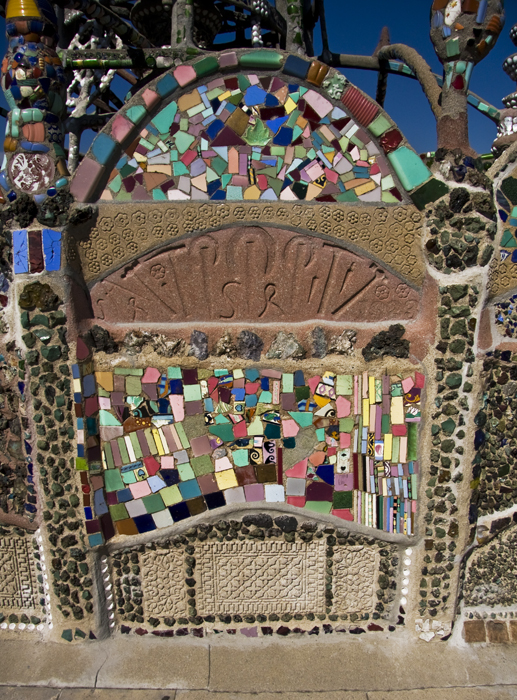
Walking around, I noticed the small perfectly carved flowers in the concrete. It took a little while to realize that they were not carved flowers, but the simple design from the top of a faucet handle pressed into the concrete.
I think that is part of the wonder of this place, he took abandoned items, things people did not want any more, and made them beautiful.

At the time Mr. Rodia drove a 1927 Hudson back and forth to work. At the same time someone driving the same type of car had installed a police siren on the roof of their car, which they used to get the cars out of their way to hurry up their journey to and from work.
Not surprisingly, the police too offence to this and began a search for the car and the driver. At which time the car promptly disappeared.
In 1999 the area around the towers was dug up to build an amphitheatre and park, which is when they found a buried 1927 Hudson automobile.
There is, of course, no proof that Mr. Rodia was the one who attached the siren to his car, and that makes me like him even more.
Despite the seemingly random placement of the pieces, there is a theme to the project. And that is nautical. As the lot is a triangle, the pointy bit is the prow, and that is where he placed his version of a model of a ship.
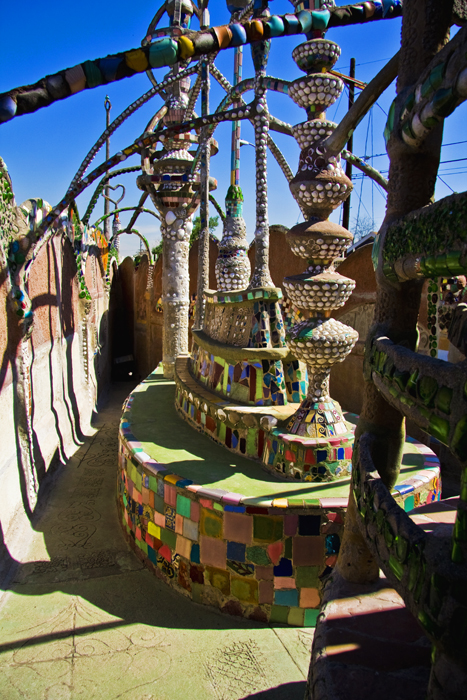
Set behind the ship are the three towers, which represent the three masts of a sailing ship.
It was at this point that I began to inspect the detail. I was told that the frame for the towers is steel, covered with his own version of concrete. On top of the cement Mr. Rodia covered it with shiny things.
Lost and lots of shiny things.
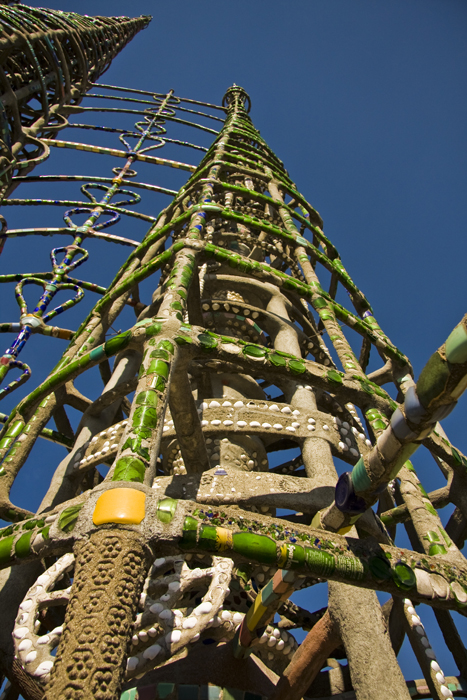
Mr. Rodia never used a ladder, he climbed up his structure, and used a window washing hammock, or a loop of wire to keep him from falling.
Later in life, as he was finishing the project, he became more and more crotchety and would slam the door in visitor’s faces. In 1954 he gave the property to a neighbor and moved up the Northern California to live with the family he had not seen in thirty years.
He never saw the towers again, but in 1959 the City of Los Angeles decided to tear down the towers because they were a hazard to the surrounding homes. The local community was outraged, so the city brought in cranes and engineers to test the strength of the towers. The crane broke before the towers, so they were allowed to stay.
I wondered, as I walked through Mr. Rodia’s legacy, why he had done this. What drove him to build these monuments?
From a man who traveled around the world, married with children, only to be a drunk and leave them, to settle in Watts, and to build these amazing structures.
And not only to build three large phallic symbols, but also to cover it with flowers and hearts.
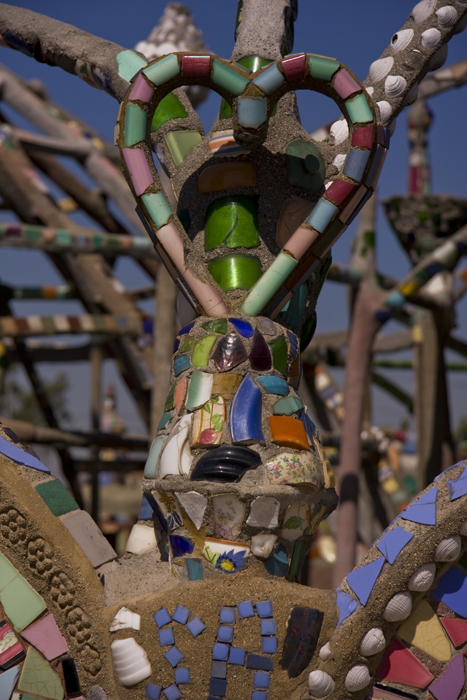
We will of course never know all the things that went through Mr. Rodia’s head, or the reason he built these towers, but we can go and visit his creation, and stand and wonder at the monument he left, for no particular reason.
The Watts Towers are open for tours on Friday, Saturday and Sunday. Tours happen every 30 minutes. Visit http://www.wattstowers.us/ for more information.
